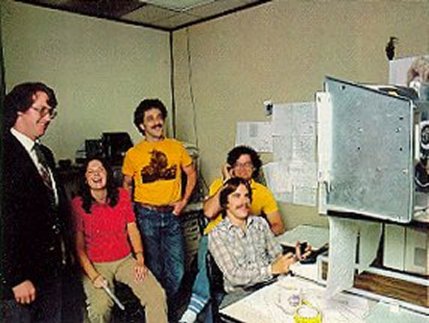

|
from Smithsonian Magazine, September 1981 This article was an expose' on the brainstorming of Atari programmers and the future of computing in general. There is a picture of several of us sitting in a lab playing a prototype game. I am the person in the picture who is actually playing the game, and I was also quoted anonymously in the article. Here is the picture in question:  l-r: Lyle Rains, Dona Bailey (Centipede), Ed Rotberg (Battlezone), Owen Rubin (me), Jeff Boscole The person in the glasses at the far right was Jeff Boscole, the game designer. The reason everyone is laughing in the picture was that I was tearing this game apart! I think I had commented that I was playing attack of the Killer IUDs or something like that. Ed Rotberg was the project lead, and had come up with a concept for a new version of Battlezone and Missile Command. You were supposed to drive the tank around and missiles would "pop-up" out of their silos and start counting down. You had to shoot them before they launched. You will note I am playing with Battlezone tank controls. On the screen were a bunch of Copper 7 IUD looking devices that would spin and "jump" about the screen. It looked like the designer was on a bad trip, and maybe he was, but it was complete nonsense, no game play, and complete garbage going on. And this after 6 months! It was NOT fun, and made no sense. It was more like a screen saver of strange shapes. The controls simply zoomed the image and rotated it in a circle, or caused it to slide left/right or up/down. Pressing the fire button caused some small little dots to fly out on the screen in no particular direction and do nothing as far as I could tell! It simply made no sense! This was my quote in the article: "For me," says another, "a tough day is trying to find those two little bugs in my game, so I spend hours playing it. Sometime, of course, you have to spend hours pushing a pencil. And for most people here, pushing a pencil is the most aggravating thing they could do." Click here to read the entire article. We'd like to give special thanks to Curtis Hart for allowing us to use his HTML-ized version of this article. You can see the original version of this, plus many many other great classic gaming articles at Curt's site here. Curt's a true historian of classic arcade games, and his site is a must-visit for those who share his enthusiasm. |

|